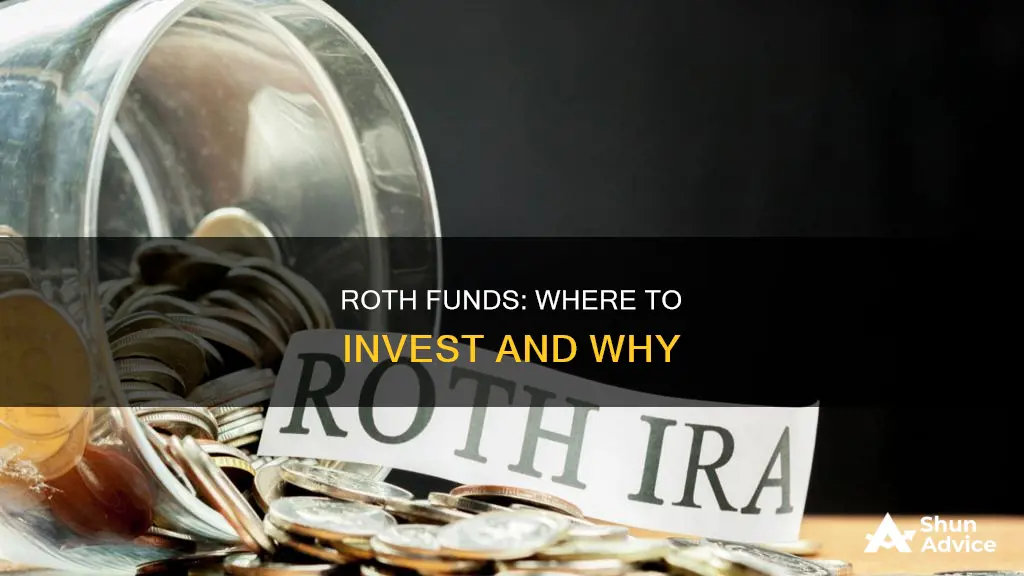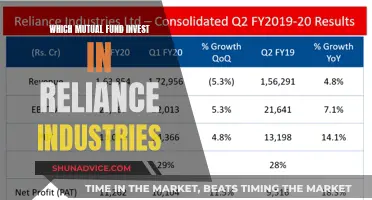
A Roth IRA is a type of individual retirement account (IRA) that allows you to contribute after-tax money to save for retirement. The main draw of a Roth IRA is that the money grows tax-free and can be withdrawn tax-free after age 59 1/2 as long as the account has been open for at least five years. The best investments for your Roth IRA include small-cap stocks and mutual funds, international stocks, and high-dividend stocks.
| Characteristics | Values |
|---|---|
| Type | Individual retirement account (IRA) |
| Taxation | After-tax dollars |
| Withdrawals | Tax-free after age 59 1/2, provided the account has been open for at least five years |
| Contributions | After-tax dollars |
| Investment options | Mutual funds, stocks, bonds, exchange-traded funds (ETFs), certificates of deposit (CDs), money market funds, gold, investment real estate, partnerships, tax liens, franchises, cryptocurrency |
| Income limits | $146,000 for single filers or $230,000 for joint filers (2024) |
| Contribution limits | $7,000 for those under 50, $8,000 for those 50 and older (2024) |
What You'll Learn

US Stock Index Funds
You can choose either a total market fund or an S&P 500 index fund. US total market funds attempt to replicate the performance of the entire US equity market, including small-cap and mid-cap stocks. In contrast, an S&P 500 index fund focuses solely on large-cap stocks. Small- and mid-cap stocks may exhibit higher volatility but produce higher returns.
There is strong evidence that index funds generally outperform actively managed funds over the long term due to differences in costs, such as management fees. A passively managed US stock index fund can benefit from the growth of the US equity market over time and avoid the significant trading costs associated with actively managed funds.
A broad-based US stock index fund carries a certain degree of risk but provides strong growth opportunities and is foundational for a long-term retirement account. However, those with a very low-risk tolerance or who are approaching retirement may want to reduce their risk exposure by allocating a larger portion of their portfolio to income-oriented assets, such as bonds.
- Vanguard 500 Index Fund Admiral Shares (VFIAX)
- Fidelity 500 Index FXAIX
- Fidelity Mid Cap Index FSMDX
- Fidelity Total Market Index FSKAX
- Fidelity ZERO Large Cap Index FNILX
- IShares Core S&P 500 ETF IVV
- IShares Core S&P Total US Stock Market ETF ITOT
- IShares S&P 500 Index WFSPX
- Schwab US Mid-Cap Index SWMCX
- Schwab Total Stock Market Index SWTSX
- Schwab US Broad Market ETF SCHB
Mutual Fund Investment: Current Smart Choices
You may want to see also

US Bond Index Funds
When considering US Bond Index Funds, it is important to remember that while they offer more stable and secure sources of income compared to stocks, they also tend to generate lower returns. However, they can be a valuable tool for risk-averse investors and those looking to diversify their portfolios.
For long-term retirement portfolios, investors often seek exposure to both stocks and bonds. This can be achieved through a single stock index fund paired with a single bond index fund or through a balanced fund that holds both. The exact ratio of stocks to bonds will depend on factors such as the investor's age, life expectancy, risk tolerance, financial goals, and income priorities.
When selecting a US Bond Index Fund, it is important to consider the fund's expense ratio, which represents the cost incurred by the fund's managers. Lower expense ratios are generally preferable as they result in higher returns for the investor. Additionally, investors should consider the fund's turnover ratio, which indicates how often the fund replaces lower-yielding bonds with higher-rate assets as interest rates rise. A higher turnover ratio can help capture higher yields, but it may also lead to higher costs.
- TIAA-CREF Bond Index Advisor (TBIAX)
- Northern Bond Index (NOBOX)
- Vanguard Total Bond Market Index Fund Admiral Shares (VBTLX)
- Schwab U.S. Aggregate Bond Index Fund (SWAGX)
- Fidelity Sustainability Bond Index Fund (FNDSX)
- Fidelity U.S. Bond Index Fund (FXNAX)
Savings Strategy: Mutual Funds Investment Allocation
You may want to see also

Global Stock Index Funds
A Roth IRA is a type of tax-advantaged individual retirement account that allows you to grow your money tax-free and withdraw it without paying taxes in retirement. When constructing a portfolio for your Roth IRA, you have a variety of investment options to choose from.
By investing in a broad-based U.S. stock index fund, a broad-based U.S. bond index fund, and a global stock index fund, investors can achieve significant diversification and maximize returns over the long term while minimizing risks.
Maximizing Your HSA Funds: Smart Investment Strategies
You may want to see also

Dividend Stock Funds
When choosing a dividend stock fund, look for funds with a long history of consistent and increasing dividend payments, such as "dividend aristocrats". To reduce risk, choose a fund that offers diversification, such as a dividend ETF or mutual fund. Passively managed funds tend to have lower fees than actively managed funds and often provide better returns.
Retirement Fund Investment: Choosing the Right Option
You may want to see also

Value Stock Funds
Because of their (usually) lower volatility, value stock funds make an attractive addition to a Roth IRA. And of course, any dividends can be plowed right back into the value stock fund, too.
Best S&P Index Funds: Top Picks for Your Portfolio
You may want to see also
Frequently asked questions
A Roth IRA is a type of individual retirement account (IRA) that allows you to contribute after-tax money to save for retirement. The money grows tax-free and can be withdrawn tax-free after age 59 1/2 as long as the account has been open for at least five years.
The main benefit of a Roth IRA is the potential tax savings. You've already paid taxes on your contributions, so you won't pay taxes on withdrawals in retirement. This is especially beneficial if you expect to be in a higher tax bracket when you retire.
Some disadvantages of Roth IRAs include no upfront tax break, lower annual contribution limits compared to 401(k)s, and contribution limits or restrictions for high-income individuals.
The best investments for a Roth IRA depend on your risk tolerance and investment goals. Some good options include dividend stock funds, S&P 500 index funds, Nasdaq-100 index funds, and small-cap stock funds.
You can open a Roth IRA at a traditional broker or robo-advisor. Before opening an account, check your income eligibility and contribution limits, which depend on your tax filing status and income.







